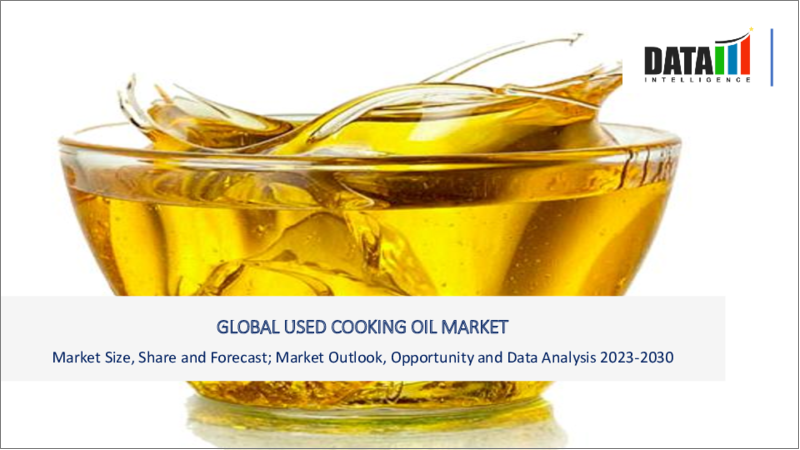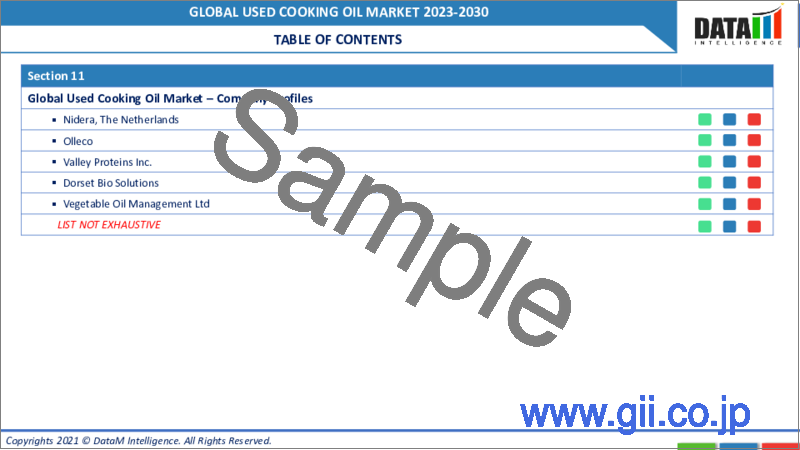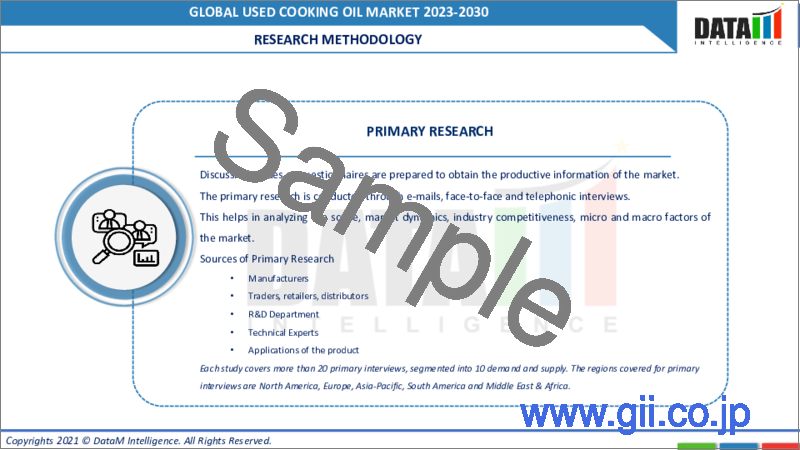|
|
市場調査レポート
商品コード
1176594
使用済み食用油の世界市場-2023-2030Global Used Cooking Oil Market - 2023-2030 |
||||||
|
● お客様のご希望に応じて、既存データの加工や未掲載情報(例:国別セグメント)の追加などの対応が可能です。 詳細はお問い合わせください。 |
|||||||
| 使用済み食用油の世界市場-2023-2030 |
|
出版日: 2022年12月26日
発行: DataM Intelligence
ページ情報: 英文 170 Pages
納期: 約2営業日
|
- 全表示
- 概要
- 目次
市場概要
使用済み食用油市場は、予測期間(2023年~2030年)にCAGR7.4%で成長すると予測されています。
使用済み食用油は、食品加工業、レストラン、ファストフードセンター、家庭で揚げ物や調理に使用されています。また、豆類や野菜などの家庭の常備菜(ベジタリアンでないものも含む)も油で調理されます。ほとんどの家庭で、食用油は再利用されています。ホテル、レストラン、屋台、道端の食堂などでは、経費節減と利益創出のため、油の再利用を繰り返しています。残った食用油は、ひまわり、トウモロコシ、菜種、オリーブ、パーム、菜種、大豆油、動物性油脂から得られます。使用済み食用油は、主に石鹸、堆肥、油脂化学製品、水素添加植物油(HVO)、工業用グリース、バイオディーゼル、動物用飼料の製造に使用されています。バイオベース燃料の採用が世界的に進んでいることが、予測期間中の市場成長を後押ししています。
市場力学:使用済み食用油の産業用途の増加が市場成長の原動力
使用済み食用油は、バイオ燃料、動物飼料、堆肥化、石鹸、ランプオイル、塗料除去剤、シャンプーや保湿剤、車の洗浄材、家具や家電の材料など、産業界で幅広い用途に使用されています。社会のエコ化が進み、石油系ディーゼルの代替燃料としての需要が高まる中、使用済み食用油の需要も高まっています。使用済み食用油は、石油に代わるクリーンな燃料としてバイオ燃料の製造に使用され、1ガロン当たりの二酸化炭素排出量を最大85%削減するのに役立ちます。また、使用済み食用油は家畜の飼料としても利用されています。使用済み食用油を分解・精製すると、多くのカロリーと栄養素を含む飼料になります。鶏肉やその他の家畜など、さまざまな産業レベルで使用されています。使用済み食用油は、苛性ソーダと水と一緒に石鹸を作る際にも使用されます。食用油を塗布することで、表面に付着した塗料を除去することができます。使用済み食用油は、錠前や鍵の機構、きしむ蝶番などを滑らかにするなど、さまざまな家庭用品の潤滑油として使用できます。錆の発生を抑止するために使用されます。髪をやわらかくし、頭皮を保湿する効果があるため、コンディショナーやシャンプーなどのヘアソープにも使用されています。自動車やトラックの表面に付着した汚れなどを落とすのに使用されています。また、革製家具を保護し、その素材を長持ちさせるためのコーティング剤としても使用されています。このような使用済み食用油の用途が、予測期間中の市場成長の原動力となっています。
市場セグメンテーション:使用済み食用油の世界市場では、バイオディーゼル分野が最も高いシェアを占めている
廃棄物リサイクルの技術的進歩により、人々は環境に有益な製品のリサイクルを行うようになりました。使用済み食用油を使用して製造されたバイオディーゼルは、炭素排出量が少なく、燃焼能力も明確です。また、一酸化炭素の排出量も少なく、石油系ディーゼルに比べて費用対効果に優れています。Statistaのデータによると、インドにおけるバイオディーゼル生産量は2022年に1億8500万リットルに達すると予測されています。バイオディーゼルは、植物油、動物性油脂、廃油から生産されます。中国のバイオディーゼル生産量は、2022年には約24億リットルになると予測されます。このようなバイオディーゼル生産量の増加が、使用済み食用油の需要を生み出しています。さらに、バイオディーゼルにおける政府のイニシアチブの増加が、市場の成長を後押ししています。例えば、2019年8月、インド政府は、100都市で食用油をバイオディーゼルに変換する新しいプログラムを開始しました。
地理的浸透:予測期間中、北米が圧倒的なシェアを占める
使用済み食用油市場では、予測期間中、北米が圧倒的な地域となっています。米国とカナダは、バイオディーゼル生産用の使用済み食用油の高い需要により、この地域の支配的な国となっています。北米政府は、カフェ、レストラン、ホテル、ケータリング事業者などからの廃食油の回収・処理を促進するための取り組みを行っています。また、廃食用油のリサイクルに関する意識の高まりも、予測期間中の市場成長を後押ししています。さらに、持続可能なエネルギー資源の使用に関する消費者の意識の高まり。同地域で使用済み食用油の回収・処理に参入する大手企業の増加も、市場の成長をさらに後押しします。
目次
第1章 調査手法と範囲
- 調査手法
- 市場の範囲
第2章 主な動向と発展
第3章 エグゼクティブサマリー
- ソース別市場内訳
- アプリケーション別市場内訳
- 地域別市場内訳
第4章 市場力学
- 市場影響要因
- 促進要因
- 抑制要因
- ビジネスチャンス
- 影響分析
第5章 産業分析
- ポーターのファイブフォース分析
- バリューチェーン分析
- 特許分析
- 規制分析
第6章 COVID-19の分析
- COVID-19の市場分析
- COVID-19以前の市場シナリオ
- COVID-19の現在の市場シナリオ
- COVID-19の後、または将来のシナリオ
- COVID-19の中での価格ダイナミクス
- 需要-供給スペクトラム
- パンデミック時の市場に関連する政府の取り組み
- メーカーの戦略的取り組み
第7章 供給元別
- フードサービス
- 家庭
第8章 用途別
- バイオディーゼル
- 動物飼料
- その他
第9章 地域別
- 北米
- 米国
- カナダ
- メキシコ
- 南米
- ブラジル
- アルゼンチン
- その他の南米地域
- 欧州
- ドイツ
- 英国
- フランス
- スペイン
- イタリア
- その他の欧州地域
- アジア太平洋地域
- 中国
- インド
- 日本
- オーストラリア
- その他アジア太平洋地域
- 中東・アフリカ地域
第10章 競合情勢
- 競合シナリオ
- 競合の戦略分析
- 市況/シェア分析
- M&A(合併・買収)分析
第11章 企業プロファイル
- Georgia-Pacific Chemicals LLC
- 企業概要
- 製品ポートフォリオと説明
- 主なハイライト
- 財務概要
- Kraton Corporation
- Eagle Imports
- PAG KIMYA SAN. TIC. LTD. STI.
- GrantChem, Inc.
- AKAY TIC SAN KOLL STI-YUKSEL AKAYLAR
- Fujian Qina Trading Co. Ltd.
- IBRAHIM WALI MOHAMMAD & CO
- G.C. RUTTEMAN & Co. B.V.
- MALPLAST INDUSTRIES LIMITED
第12章 DataM
Market Overview
Used Cooking Oil Market were valued at USD YY million in 2022. It is forecasted to reach USD YY million by 2030, growing at a CAGR of 7.4% during the forecast period (2023-2030).
Used cooking oil is used for frying or cooking in the food processing industry, restaurants, fast food centers and households. Home-made regular meals like pulses, and vegetables, including non-vegetarian preparations, are also cooked in oil. In most of the households cooking oil is reused. Hotels, restaurants, food stalls, and roadside eateries engage in reusing oil repeatedly to save on costs and build up profit. Leftover cooking oil is obtained from sunflower, corn, canola, olive, palm, rapeseed, soya oils and animal fats. Used cooking oil is mostly used for manufacturing soaps, composts, oleochemicals, hydrogenated vegetable oils (HVO), industrial greases, biodiesels and animal feed. The increasing adoption of bio-based fuel globally drives the market growth in the forecast period.
Market Dynamics: An increase in the industrial applications of used cooking oil drives the market growth
Used cooking oil has a wide range of applications in the industry, such as it is used as biofuel, animal feed, composting, soaps, lamp oil, paint remover, shampoo and moisturizer, car cleaning material, furniture and appliance material. As society becomes more eco-friendly and demand for an alternative to petroleum diesel increases, demand for used cooking oil increases. Used cooking oil is used in producing biofuels as a clean-burning alternative to petroleum that helps reduce carbon emissions by up to 85 percent per gallon. Used cooking oil is also used in animal feed. When used, cooking oil is stripped down and refined; it offers a lot of calories and nutrients to the animal feed. It is used in various industry levels, like poultry and other forms of livestock. Used cooking oil is mixed with pet food to add more taste. It helps to improve the taste of food and helps keep their coat of fur slick and shiny.Vegetable oil is mostly used in composting due to its organic nature. Used cooking oil is also used in soap making with caustic soda flakes and water; the used oil is a useful ingredient in hand soaps. Cooking oil removes paint from different surfaces by applying it to the afflicted area. Used cooking oil is a lubricant for various household products, such as smoothing lock-and-key mechanisms, creaky hinges and other things. It is used to help deter rust from accumulating. Used cooking oil is also used in hair soap products like conditioner and shampoo because it helps to soften the hair and moisturize the scalp. Used cooking oil removes dirt and other debris from the surface of cars and trucks. It is also used in coating leather furniture to protect it and preserve the material's longevity. These applications of the used cooking oil drive market growth in the forecast period.
Market Segmentation: Biodiesel segment accounted for the highest share in global used cooking oil market
Technological advancement in waste recycling encouraged people to recycle product that is beneficial for the environment. Biodiesel, produced using used cooking oil, has low carbon emission and clear burning capacity. They also release fewer amounts of carbon monoxide and are cost-effective compared to petroleum diesel. According to Statista data, biodiesel production in India was forecast to stand at 185 million liters in 2022. Biodiesel is produced from vegetable oil, animal fats, and waste oils. China's biodiesel production is forecast to amount to roughly 2.4 billion liters in 2022. This increase in biodiesel production creates demand for the used cooking oil. Moreover, an increase in Government initiatives in biodiesel drives the market growth. For instance, in Aug 2019, the Government of India launched a new program for converting cooking oil into biodiesel in 100 cities. In India, 2,700 crore liters of cooking oil is used, out of which 140 crore UCO can be collected from the bulk consumer such as hotels, restaurants and canteens for conversion, which will give around 110 crore liters of biodiesel every year.
Geographical Penetration: North America is the dominating region during the forecast period.
North America is the dominating region in the used cooking oil market in the forecast period. The United States and Canada are the dominating countries in the region due to the high demand for used cooking oil for biodiesel production. The government of North America is taking initiatives to promote the collection and processing of waste cooking oil from cafes, restaurants, hotels and catering businesses. Also, increasing awareness about recycling waste cooking oil drives the market growth in the forecast period. Moreover, increase in consumer awareness about the use of sustainable energy resources. An increase in the number of major companies entering into the collection and processing of used cooking oil in the region will further boost the market growth.
Competitive Landscape:
There are several established participants in the industry and local manufacturers; hence, the market is fragmented. Some major market players are Georgia-Pacific Chemicals LLC, Kraton Corporation, Eagle Imports, and Pag Kimya San. Tic. Ltd. Sti., Grantchem, Inc., Akay Tic San Koll Sti - Yuksel Akaylar, Fujian Qina Trading Co. Ltd., Ibrahim Wali Mohammad & Co, G.C. Rutteman & Co. B.V., And Malplast Industries Limited. Some major companies launched new products in the market to expand their business. For instance, on 18 March 2022, Kraton and Saudi Basic Industries SABIC Launched Renewable Butadiene, a Previously Launched Bio-PC Resin. SABIC Certified Renewable Butadiene is derived from second-generation renewable feedstocks free of animal and palm oil, such as tall oil by-products from the pulping of wood pulp in the paper industry, which does not directly compete with humans for food and animal feed. On May 2021, India started experimenting with doping diesel with a small portion of biodiesel extracted from leftover cooking oil in the kitchen to cut reliance on imports and reduce carbon emissions. Around 23 million tons of edible oil are consumed in India annually. There is potential to generate 222 crore liter of UCO annually, but no structure exists for collagen of waste cooking oil. To encourage these companies floaded an expression of interest seeking biodiesel made from Used Cooking Oil, offering a fixed price for five years and guaranteed offtake for ten years. Also, In January 2020, Biodiesel producer BioD Energy plans to set up two new bio-diesel plants. One of these will be set up locally with a doubling capacity of the Haryana plant, whereas the other is located in Dubai with the same capacity as the Haryana facility.
COVID-19 Impact: Negative impact on the global used cooking oil market
The supply chain of used cooking oil is completely disturbed during the pandemic due to the strict government regulations on the import and export of the product. Price fluctuation of the used cooking oil also negatively affected the market growth. Major key players of used cooking oil suspended their operations in different locations due to the lockdown and social distancing norms. The market is one of those that have lost investors due to a lack of transportation, labor, and other facilities. Consumption of used cooking oil decreased due to the closure of hotels and restaurants during the pandemic. In covid, which impacted their disruption in the distribution network, used cooking oil struggled to sell their finished goods. Shutting down the food service industry impacted the market negatively.
The global used cooking oil market report would provide an access to approximately 53 market data tables, 44 figures and 170 pages.
Table of Contents
1. Scope and Methodology
- 1.1. Research Methodology
- 1.2. Scope of the Market
2. Key Trends and Developments
3. Executive Summary
- 3.1. Market Snippet by Source
- 3.2. Market Snippet by Application
- 3.3. Market Snippet by Region
4. Market Dynamics
- 4.1. Market impacting factors
- 4.1.1. Drivers
- 4.1.2. Restraints
- 4.1.3. Opportunities
- 4.2. Impact analysis
5. Industry Analysis
- 5.1. Porter's five forces analysis
- 5.2. Value chain analysis
- 5.3. Patent Analysis
- 5.4. Regulatory Analysis
6. COVID-19 Analysis
- 6.1. Analysis of Covid-19 on the Market
- 6.1.1. Before COVID-19 Market Scenario
- 6.1.2. Present COVID-19 Market Scenario
- 6.1.3. After COVID-19 or Future Scenario
- 6.2. Pricing Dynamics Amid Covid-19
- 6.3. Demand-Supply Spectrum
- 6.4. Government Initiatives Related to the Market During Pandemic
- 6.5. Manufacturers Strategic Initiatives
7. By Source
- 7.1. Introduction
- 7.1.1. Market size analysis, and y-o-y growth analysis (%), By Source Segment
- 7.1.2. Market attractiveness index, By Source Segment
- 7.2. Food Services*
- 7.2.1. Introduction
- 7.2.2. Market Size Analysis, US$ Million, 2020-2029 And Y-O-Y Growth Analysis (%), 2021-2029
- 7.3. Households
8. By Application
- 8.1. Introduction
- 8.1.1. Market size analysis, and y-o-y growth analysis (%), By Application Segment
- 8.1.2. Market attractiveness index, By Application Segment
- 8.2. Biodiesel*
- 8.2.1. Introduction
- 8.2.2. Market Size Analysis, US$ Million, 2020-2029 And Y-O-Y Growth Analysis (%), 2021-2029
- 8.3. Animal Feed
- 8.4. Others
9. By Region
- 9.1. Introduction
- 9.1.1. Market Size Analysis, And Y-O-Y Growth Analysis (%), By Region
- 9.1.2. Market Attractiveness Index, By Region
- 9.2. North America
- 9.2.1. Introduction
- 9.2.2. Key region-specific dynamics
- 9.2.3. Market Size Analysis, And Y-O-Y Growth Analysis (%), By Source
- 9.2.4. Market Size Analysis, And Y-O-Y Growth Analysis (%), By Application
- 9.2.5. Market Size Analysis, And Y-O-Y Growth Analysis (%), By Country
- 9.2.5.1. U.S.
- 9.2.5.2. Canada
- 9.2.5.3. Mexico
- 9.3. South America
- 9.3.1. Introduction
- 9.3.2. Key Region-Specific Dynamics
- 9.3.3. Market Size Analysis, And Y-O-Y Growth Analysis (%), By Source
- 9.3.4. Market Size Analysis, And Y-O-Y Growth Analysis (%), By Application
- 9.3.5. Market Size Analysis, And Y-O-Y Growth Analysis (%), By Country
- 9.3.5.1. Brazil
- 9.3.5.2. Argentina
- 9.3.5.3. Rest of South America
- 9.4. Europe
- 9.4.1. Introduction
- 9.4.2. Key Region-Specific Dynamics
- 9.4.3. Market Size Analysis, And Y-O-Y Growth Analysis (%), By Source
- 9.4.4. Market Size Analysis, And Y-O-Y Growth Analysis (%), By Application
- 9.4.5. Market Size Analysis, And Y-O-Y Growth Analysis (%), By Country
- 9.4.5.1. Germany
- 9.4.5.2. U.K.
- 9.4.5.3. France
- 9.4.5.4. Spain
- 9.4.5.5. Italy
- 9.4.5.6. Rest of Europe
- 9.5. Asia Pacific
- 9.5.1. Introduction
- 9.5.2. Key Region-Specific Dynamics
- 9.5.3. Market Size Analysis, And Y-O-Y Growth Analysis (%), By Source
- 9.5.4. Market Size Analysis, And Y-O-Y Growth Analysis (%), By Application
- 9.5.5. Market Size Analysis, And Y-O-Y Growth Analysis (%), By Country
- 9.5.5.1. China
- 9.5.5.2. India
- 9.5.5.3. Japan
- 9.5.5.4. Australia
- 9.5.5.5. Rest of Asia Pacific
- 9.6. Middle East and Africa
- 9.6.1. Introduction
- 9.6.2. Key Region-Specific Dynamics
- 9.6.3. Market Size Analysis, And Y-O-Y Growth Analysis (%), By Source
- 9.6.4. Market Size Analysis, And Y-O-Y Growth Analysis (%), By Application
10. Competitive Landscape
- 10.1. Competitive scenario
- 10.2. Competitor strategy analysis
- 10.3. Market positioning/share analysis
- 10.4. Mergers and acquisitions analysis
11. Company Profiles
- 11.1. Georgia-Pacific Chemicals LLC*
- 11.1.1. Company Overview
- 11.1.2. Product Portfolio and Description
- 11.1.3. Key Highlights
- 11.1.4. Financial Overview
- 11.2. Kraton Corporation
- 11.3. Eagle Imports
- 11.4. PAG KIMYA SAN. TIC. LTD. STI.
- 11.5. GrantChem, Inc.
- 11.6. AKAY TIC SAN KOLL STI - YUKSEL AKAYLAR
- 11.7. Fujian Qina Trading Co. Ltd.
- 11.8. IBRAHIM WALI MOHAMMAD & CO
- 11.9. G.C. RUTTEMAN & Co. B.V.
- 11.10. MALPLAST INDUSTRIES LIMITED
- List not Exhaustive*
12. DataM
- 12.1. Appendix
- 12.2. About us and services
- 12.3. Contact us




